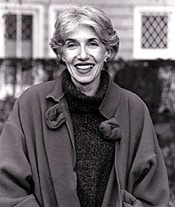
Dava Sobel
Winter 2005
Course: Writing about Science
Links:
- The Uncommon Interview: Dava Sobel
- Author of Galileo’s Daughter to bring her expertise in science writing to University
- Writer Dava Sobel pushes students to get the most out of their language.
Dava Sobel, a former science reporter for The New York Times, is the author of Longitude (Walker 1995, Penguin 1996), Galileo 's Daughter (Walker 1999, Penguin 2000), and The Planets (Penguin 2005). In her thirty years as a science journalist she has written for many magazines, including Audubon, Discover, Life and The New Yorker, served as a contributing editor to Harvard Magazine and Omni, and co-authored six books, including Is Anyone Out There? with astronomer Frank Drake. Ms. Sobel is also the editor of the collection Best American Science Writing 2004, published by Ecco Press.
Longitude, now in its twenty-ninth hardcover printing, was translated into two dozen foreign languages and became a national and international bestseller. It won several literary prizes, including the Harold D. Vursell Memorial Award from the American Academy of Arts and Letters and "Book of the Year" in England. The PBS science program "NOVA" produced a television documentary called "Lost At Sea -- The Search for Longitude," which was based on Ms. Sobel's book, and Granada Films of England created a dramatic version of the story, "Longitude", starring Jeremy Irons and Michael Gambon, which aired on A&E as a four-hour made-for-TV movie. Galileo's Daughter won the 1999 Los Angeles Times Book Prize for science and technology, a 2000 Christopher Award, and was a finalist for the 2000 Pulitzer Prize in biography. A two-hour "NOVA" documentary based on Galileo's Daughter, called "Galilee-s Battle for the Heavens," first aired on public television in October 2002, and won an Emmy in the category of historical programming.
Ms. Sobel received her bachelor of arts degree from the State University of New York at Binghamton, and she holds honorary doctor of letters degrees from the University of Bath, in England, and Middlebury College, Vermont. Ms. Sobel received the Harrison Medal from the Worshipful Company of Clockmakers, the 2002 Individual Public Service Award from the National Science Board, and the 2002 Bradford Washburn Award from the Boston Museum of Science.
